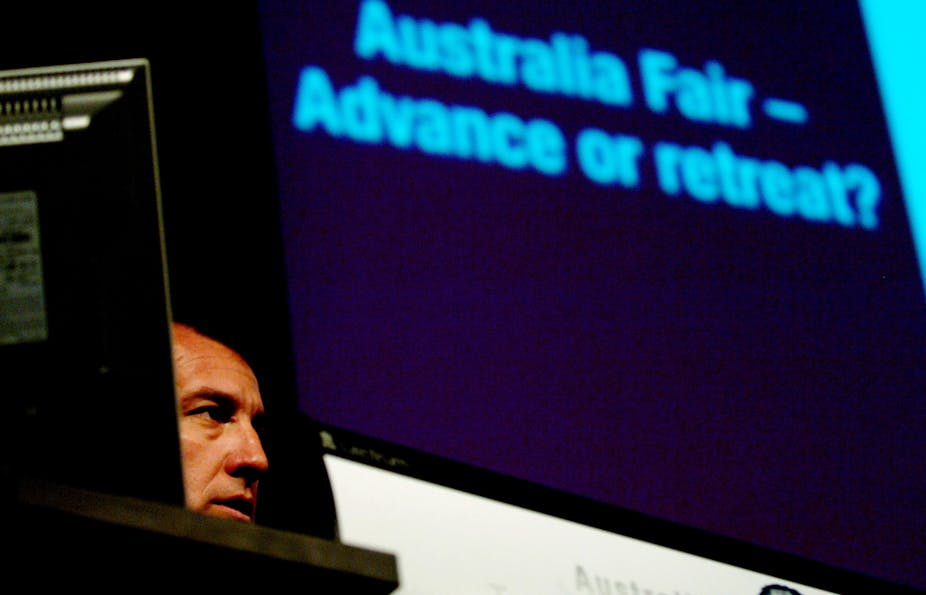One of the bizarre bipartisan policy overlaps between the Coalition and Labor is in the area of income support known as welfare payments. Labor has been seen as the party that cared about the poor and disadvantaged, but the former ALP government adopted and extended a range of the Howard government’s paternalistic and punitive measures.
Now, social services minister Kevin Andrews wants to extend significantly the costly but currently limited surveillance and control policies of income management.
Howard’s “welfare to work” strategies reduced income levels and increased surveillance of some recipients. Building on the earlier McClure report, the Coalition tightened eligibility for disability payments and cut off sole parent benefits when children turned eight.
The ALP went on to remove the the higher sole parent payment from grandfathered recipients, further tightened disability support pension criteria and work tests and failed to increase the very low Newstart payment. Labor also extended income management, a policy that began with the Northern Territory intervention.
These measures were speciously framed as inducing recipients to find paid work by cutting entitlements. Such arguments ignored the lack of evidence that earlier cuts had produced higher workforce participation. The underlying ideological beliefs are that those who fail to find a job are flawed, disorganised or lazy and need coercive controls to make them responsible.
Policy expansion defies evidence
This provides the platform for social services minister Kevin Andrews to use the budget to further cut the incomes of some of our most vulnerable people. He intends to turn the highly limited income management program into mainstream policy. This is despite a singular lack of evidence that the policy makes a significant positive difference to the lives of people in the program.
Why then would Andrews expand a program that per person cost more than half the value of the dole to administer last financial year? The Australian National Audit Office found the scheme cost between A$6600 and A$7900 a person, equal to 62% of the $246-a-week Newstart payment.
The parliamentary summary of the policy stated:
Income management has been a controversial welfare reform. While conditions have always been applied to eligibility for welfare payments, restrictions on how payments may be spent are a new development, criticised by some as paternalist and stigmatising. Income management is also relatively expensive to administer, with an estimated cost up to 2014–15 in the range of $1 billion.
Income management currently covers fewer than 24,000 people nationally, mostly Indigenous people in Northern Territory. Citing small pilot programs in Western Australia and five relatively recent non-Indigenous versions in Bankstown, Rockhampton, Shepparton, Logan and Playford, Andrews has announced plans to extend the policy. This suggests that categories of payees will be included over the whole nation – for example, all under 21 on youth allowance.
In a time when Andrews’ portfolio is seeking savings, expanding a cost-heavy program for unproven benefits is irrational. Despite running for nearly seven years, a wide range of evaluations has failed to find any clear data that show valid benefits for a significant number of those covered by income management.
The most recent publicly available review of child protection income management in Western Australia concludes with the warning:
This review relies mainly on qualitative data that provides rich descriptions of the perceptions and experiences of income management of both recipients and intermediaries. As with all qualitative studies, care should be taken in drawing conclusions, as the findings cannot be generalised; nor can those who were involved in the review be seen as a representative sample of recipients or intermediaries.

Andrews apparently based his decision on a recent evaluation report on the place-based pilots, which has not been made public. This seems premature as most of the 2000 or so participants in these five areas were recently added, very young recipients of youth allowance. It is hard to see how the early data could justify a major expansion.
The NT program is now old enough to show some clear results. The Commonwealth’s recent first evaluation, like many other reports, failed to find any. At best it found some participants who said they had good experiences of income management. Others reported seriously negative experiences.
The report stated:
There are few, if any, strong and consistent impacts of NIM; rather, there have been diverse outcomes. This is reflected in the wide and inconsistent range of views and experiences of income management.
In the NT, where compulsory income management was applied to most working-age recipients of payments since 2010, and others in mainly remote areas since 2007, official statistics do not show positive changes. The data on school attendance, violence and child protection are not good.
Many participants’ reported experiences suggest that the relatively few with some financial issues could have been helped by less-interfering programs like Centrepay without losing the right to control their spending.
Major change demands debate
This substantial shift in welfare policy has never been seriously debated because it started with Aboriginal recipients and added other outgroups. On top of the lack of evidence that quarantining at least half people’s income support improves their lives, some evidence suggests it may cause harm via shame and infantilising dependency.
Income management is therefore wrong on many levels:
It starts with the wrong assumptions, that the spending of income recipients is the problem.
It can undermine recipients’ capacities to make their own choices.
It costs a lot per person to administer, which could be better spent on other services.
It reduces the focus on external problems - such as job seekers greatly outnumbering jobs and employers’ prejudices affecting work prospects.
It blames the most vulnerable and reinforces their lack of self-worth and hostile public views, both social determinants of ill health.
Still, Andrews wants to make the policy mainstream. The policy has been under the radar because it has been bipartisan; it never became a public or election issue. Income management needs solid challenges as it fails any good policy tests.

